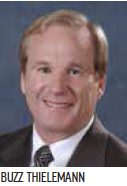Two U.S. airports – one a major hub in the North, the other a small origin-and-destination facility on the West Coast – use barely any electricity to operate some of their parking facilities, thanks to solar panels and light-emitting diode (LED) lighting.
Minneapolis-St. Paul International Airport (MSP) just turned on a $25.4 million solar array built on top of two parking garages at its Lindbergh Terminal. The 8,700 solar panels are expected to produce 3 megawatts of electricity per day.
 facts&figures facts&figures
Minneapolis-St. Paul Int’l Airport Rogue Valley Int’l-Medford Airport |
Rogue Valley International-Medford Airport (MFR) installed three more freestanding, structure-mounted solar panels in its public parking lot last year. Now with a total of seven arrays, the Oregon airport generates 77 kilowatts of power each day.
Neither airport, however, is resting on its laurels. Both are about scheduled to begin additional solar projects in the new year.
Twin Cities Sustainability
The new array at MSP is the largest solar cell installation in Minnesota, notes Dennis Probst, executive vice president of the Metropolitan Airports Commission. “And, we think it is one of the largest, if not the largest system, on a structure in the country.”
The airport’s peak daily power consumption is 20 megawatts, so the solar panels produce 15% of the peak load, Probst explains. The power is consumed in “real time” and not sold to the local power company.
To pilots in approaching aircraft, MSP’s solar array appears as two solid mirrors. Per FAA regulations, the panels were placed at an angle to prevent glare that could hamper landing aircraft. Although the angle prevents the panels from producing the maximum amount of power, it adds a vital measure of airfield safety.
The airport’s contract with Ameresco, the developer and general contractor for the project, requires the array to produce at least 3 megawatts daily.
In addition to adding solar panels, MSP as part of the project also replaced all of the lights in the Lindbergh Terminal’s four parking garages with LED technology. “We are very close to producing the same amount of energy required to power the lighting in the four parking ramps,” Probst reports. “It is the lowering of the load with the LED lights that allows us to get near the zero energy mark.”
In October, officials at the international Airports Going Green Conference recognized MSP for the size and scope of its environmental projects.
Creative Financing Required
As public entities, neither MSP nor MFR was eligible for governmental tax incentives that defray the cost of installing solar or other renewable energy generators. Such programs are designed for private firms. MSP is operated by the Metropolitan Airports Commission; MFR is an enterprise operation of Jackson County, OR. Both airports consequently turned to power industry specialists to craft financing packages for their projects. Because incentive programs vary by state and utility, each operator opted to retain a local consultant.
When Ameresco won the proposal competition to provide MSP with solar panels, it was charged with developing multiple options for officials to consider. One strategy included a third-party owner selling power to the airport under a detailed purchase agreement. Ultimately, MSP chose to own the solar infrastructure directly, explains John Neville, Ameresco’s regional director.
In its role as general contractor for the project, Ameresco tapped the federal Qualified Energy Conservation Bond program, one of the elements included in President Obama’s 2009 infrastructure investment program. As part of the program, the state of Minnesota was allocated $55 million for energy bonds, which were subsequently distributed to counties and cities. After seven counties and cities near the Twin Cities returned their unused allocations to the state, the state re-allocated those funds to MSP.
The airport sold $23.3 million in 20-year bonds at a 0.75% interest rate. Xcel Energy, the local power company, awarded the project a $2.1 million grant.
The airport is paying off the bonds with on-going savings from lower electric bills, Probst explains. Over the 30-year projected life of the solar cells, MSP expects to realize at least $10 million in energy savings above the $25.4 million project cost.
“This is good news for the airport,” Probst comments. “Not only is it providing energy and helping green the airport, but there is also a significant financial benefit.”
Across the country, MFR followed a similar route to finance its project, but without bond sales. Its three recent projects cost slightly more than $1 million, and the airport paid $391,496 from its capital reserve fund, reports Airport Director Bern E. Case.
 The airport hired Medford consulting firm RHT Energy to assemble a financing package for its first solar project, and then replicated the package for its second and third phases. The airport anticipates using the same approach yet again for an upcoming solar project. For the airport’s three projects, RHT consultant Buzz Thielemann helped secure $539,821 in grants from Pacific Power’s Blue Sky program and $68,940 from the Oregon Energy Trust.
The airport hired Medford consulting firm RHT Energy to assemble a financing package for its first solar project, and then replicated the package for its second and third phases. The airport anticipates using the same approach yet again for an upcoming solar project. For the airport’s three projects, RHT consultant Buzz Thielemann helped secure $539,821 in grants from Pacific Power’s Blue Sky program and $68,940 from the Oregon Energy Trust.
Blue Sky grants are subsidized by Pacific Power customers who choose to pay slightly higher electric rates to support renewable energy projects such as solar arrays. The Oregon Energy Trust is financed through a 3% monthly charge on electric bills from investor-owned utilities.
The Medford Way
 MFR is located in the southwest corner of Oregon, near the California border, and is served by four carriers: Alaska Airlines, Delta Air Lines, United Airlines and Allegiant Air. Last year’s total passenger volume is estimated at 750,000. Medford, the airport’s hometown, is also the birthplace of Ginger Rogers and headquarters for Harry and David, a retailer known for mail-order pears and other food gifts.
MFR is located in the southwest corner of Oregon, near the California border, and is served by four carriers: Alaska Airlines, Delta Air Lines, United Airlines and Allegiant Air. Last year’s total passenger volume is estimated at 750,000. Medford, the airport’s hometown, is also the birthplace of Ginger Rogers and headquarters for Harry and David, a retailer known for mail-order pears and other food gifts.
Numerous vendors have approached the airport about installing roof-mounted solar panels, but Thielemann advised Case against using such systems at the airport because installation crews would have to drill hundreds of holes into the membrane roof of the terminal building, which is only seven years old. The panels would also detract from the highly acclaimed design of the building, he adds. With 1,100 acres available for free-standing panels, building-mounted panels didn’t make sense.
Furthermore, Case realized that installing free-standing panels could facilitate adding a canopy that extends from the parking lot to the terminal – a feature eliminated to cut costs when the terminal was originally built. It took a series of projects, but MFR now has a de facto canopy as Case hoped.

The rules of the Blue Sky program preclude building a canopy to house solar panels, but the program was able to pay for a ground structure to house solar panels. The airport’s first solar project added a ground-mounted structure over the booth where customers pay their parking fees. “It protected the toll booth and the people when they roll down their windows,” Case remarks. “It was a sizable ground-mounted structure that held a 15-kilowatt array.”
Then, in 2013, MFR built three ground-mounted structures in its parking lot, with solar panels that provide cover to the sidewalk. This second phase generates 25 kilowatts per day. Finally, last year, the airport installed a second trio of ground-mounted structures that generates 36 kilowatts daily and shields more of the sidewalk.
 Together, six of the airport’s seven arrays effectively form a canopy, notes Case. Ron Grimes Architects designed the “canopy” arrays so the structures blend with terminal exterior.
Together, six of the airport’s seven arrays effectively form a canopy, notes Case. Ron Grimes Architects designed the “canopy” arrays so the structures blend with terminal exterior.
While all of the airport’s arrays are the same size, the 2015 batch generates more electricity than the others because photovoltaic solar cells have become more efficient.
The grants and airport funds were also used to re-lamp the public parking lot, two employee lots and the rental car lot with LED bulbs. “We now have a zero carbon footprint with our parking lot,” Case reports proudly.
With its solar arrays in place, the airport sells power to Pacific Power during the day and buys it back in the evening to light the parking lots. “We feed more than we take,” Case notes. “The power company is thrilled with the arrangement we have.”
 Thielemann considers the project a “triple win” for MFR – it produced economic benefits with lower energy bills; it’s “green” because it produces renewable energy; and it keeps customers dry at the toll booth and walking to the terminal.
Thielemann considers the project a “triple win” for MFR – it produced economic benefits with lower energy bills; it’s “green” because it produces renewable energy; and it keeps customers dry at the toll booth and walking to the terminal.
Pacific Power also loves the project, he adds, because more than 1 million area residents see Blue Sky grants at work.
What’s Next?
MFR’s upcoming fourth solar project will add panels in the rental car lot. At MSP, the board recently approved a solar project for the airport’s Humphrey Terminal. The project will install 1.3-megawatt solar panels on one of the terminal’s garages and re-lamp fixtures in both garages, at an estimated cost of $11.6 million.
Financing will be similar to the airport’s previous solar project, including low interest bonds obtained through the new Clean Renewable Energy Bond program. Construction is slated to begin in spring.

| Construction Crews Warmed Jobsite to Tap the Sun
Building an award-winning solar array on top of two poured concrete parking garages in the middle of winter presented unique challenges for Minneapolis-St. Paul International Airport (MSP). “The greatest challenge in putting solar panels on a structure is the additional incurred costs,” explains Dennis Probst, executive vice president of the Metropolitan Airports Commission. “In fact, 40% of the $25.4 million project cost went toward structural improvements we made so as to place the panels up there. We had to extend columns and then build a structural grid that we could then mount the panels to.” The bulk of the concrete work to extend 78 columns in the first garage was completed in December 2014. Ameresco, general contractor for the project, had not planned to perform concrete work in Minnesota that time of year, but learned that the local ironworkers union contract allows members to work in temperatures down to negative 20° F. To facilitate the concrete work, crews built a platform under the top parking deck and heated the underside of the structure. The process took two weeks, but the method allowed the project to proceed, explains Brian Cunningham, Ameresco’s senior project manager. The deck temperature had to be at least 50° F for the new concrete to cure; with heat added from below, the site averaged 70° F. Because propane was used to heat the deck, a fire watchman was required at all times. During construction, MSP closed the top parking decks of each garage. Once the garage’s second level was also closed for the two-week period. Weather and flight operations complicated the installation of the project’s steel superstructure, recalls Cunningham. Per FAA rules, cranes could only operate in the area when the ceiling was at least 10,000 feet to increase safety for low-flying planes. Poor daytime visibility sometimes forced steel installation crews to work at night, when there is far less air traffic. While Ameresco has worked on other airport projects, Cunningham says that no other project matched the challenges presented at MSP. Safety was a paramount concern given the weather and location of the garages along roadways, he adds. Crews wore magnetic gloves and used multiple tethers on steel beams when moving the large pieces. Furthermore, Probst describes the construction timeline in Ameresco’s contract as aggressive. Despite numerous challenges, no on-the-job injuries were reported during the recent project, notes Cunningham. The airport’s next solar project, which is slated to begin in spring, is not expected to include winter construction work. |



